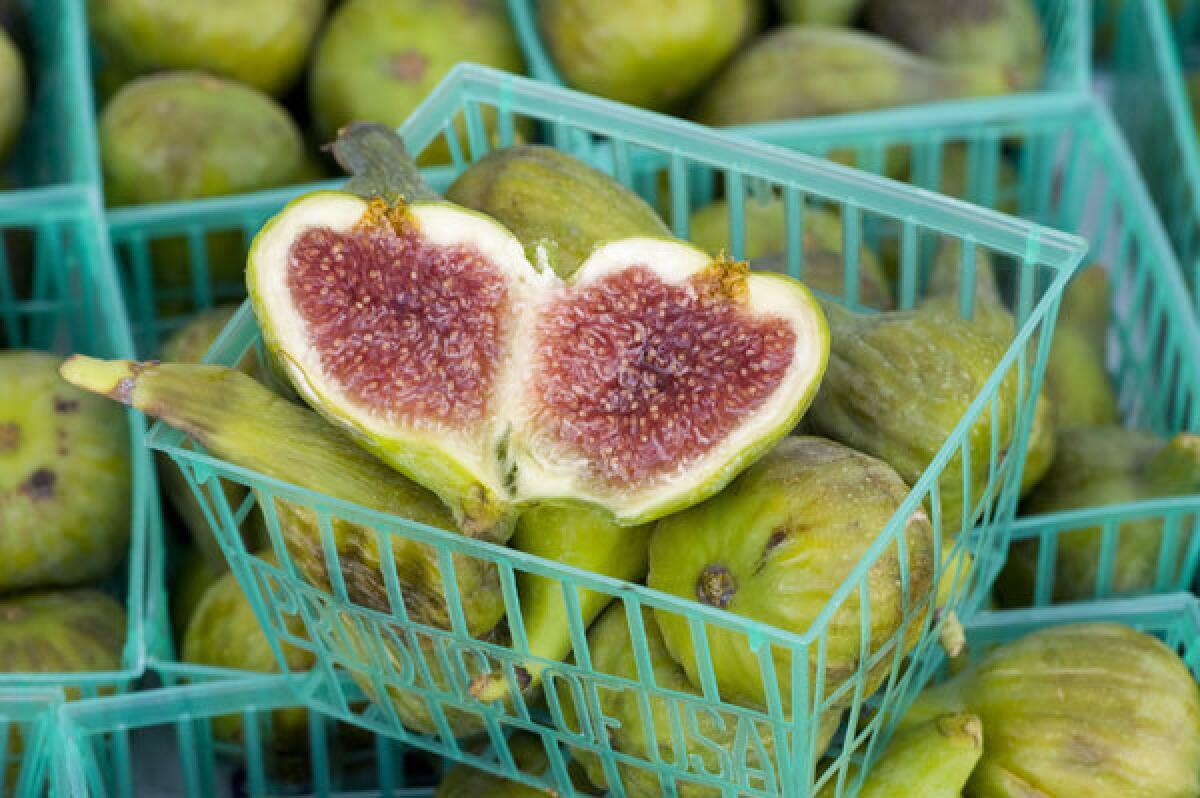Market Watch: The short, happy life of Adriatic figs

- Share via
This seems to be a banner season for figs, which are practically made for farmers markets, since they are only at their best when fully ripe, at which point they are too perishable to ship commercially. The Adriatic variety, with thin green skin and strawberry flesh that’s so sweet it’s almost like jam at peak ripeness, is one of the most luscious of figs but rarely encountered fresh, even at farmers markets, because of this fragility; most go to make dried figs and fig paste.
The second and main crop just started for Mark Boujikian of Raisin City, near Fresno, who does such a superb job with fresh Adriatics that many customers dream about them for the 10 months they’re unavailable. They are sold in green plastic pint containers, so one can’t select individual fruits; the key is to get to the market early and try to pick out the containers with the greatest proportion of really ripe fruits. The fig lover develops almost a mystical rapport with his fruit, alert to the many external hints — striated or stretch-marked skin, a touch of sunburn and a drop of honey at the bottom — that a supreme treat lies within.
PHOTOS: Market Watch columnist David Karp captures what’s fresh this week at the market:
Boujikian sells at Torrance (both Saturday and Tuesday), Irvine, Hollywood, Encino and other markets.
***
Southern California is the best place in the nation to buy avocados year-round, but getting good fruit in late summer requires careful attention. By now the summer heat in north San Diego County, the leading production area, as well as in other inland zones, has overmatured the standard Hass variety on the tree, so that once harvested it can pass from hard to rancid in a day or two. The skin gets thin and crumbly, the seed sprouts, the texture goes mushy and the fruit is good only for guacamole.
By compensation, Hass grown in cooler coastal climates, in Ventura (from Santa Paula west) and Santa Barbara counties and points north, are still likely to be of good quality and increasingly rich in the oil that’s the fruit’s main selling point.
Another strategy is to look for Lamb Hass, which is really a different variety descended from and similar to Hass, but later in the season and thus more likely to still be of good quality now when grown in warm areas like Fallbrook or Riverside. Commercially it is usually marketed as Hass, but Lamb Hass tends to be larger and has a blunter stem end and slightly lower oil content.
Reed, a large, round variety of the Guatemalan type, is another good late-maturing choice in this season. It’s a little trickier than Hass to tell when Reed is ripe, because the skin is thick and it stays green, but the seed is very small, so there’s a lot of flesh, and it’s usually of good quality.
***
John Hurley of Summer Harvest Farms, from Dinuba, has two interesting and delicious oddities this week. One is a selection of a yellow-skinned and white-fleshed Aprium (a hybrid of apricot and plum, more like an apricot) with a sweet melony flavor. Breeders and plant explorers have been striving for decades to come up with good white apricots, and this variety, bred by Zaiger Genetics of Modesto, is one of the first such fruits to appear at farmers markets in the Southland.
Hurley, who sells at both Santa Monica Saturday markets, as well as at Beverly Hills on Sundays, also has an unusual white-fleshed peach with a bizarre strip of yellow skin and flesh next to the suture that joins the two halves of the fruit. In other respects it is a typical, old-fashioned white peach, with high aromatics and a good balance of sweetness and acidity. Hurley, who obtained the variety from a neighbor, has not known its name and dubbed it ‘Gold Line’; but Desmond Layne, a peach specialist at Clemson University, suggested that it was probably Lady Nancy, a limb mutation of a New Jersey variety that arose in that state in the 1980s.
food@latimes.com
More to Read
Eat your way across L.A.
Get our weekly Tasting Notes newsletter for reviews, news and more.
You may occasionally receive promotional content from the Los Angeles Times.










